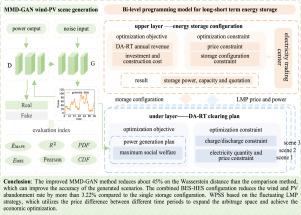A multi-scale energy storage configuration planning method with improved MMD-GAN wind–photovoltaic scene generation
IF 8.9
2区 工程技术
Q1 ENERGY & FUELS
引用次数: 0
Abstract
Increasing proportion of new energy puts new demands on the flexibility regulation capability of the new power system. To this end, a long–short term wind–PV–storage station cooperative optimization planning method is established to take into account the economy and multi-scale and multi-objective. Firstly, an improved MMD-GAN is used to generate the wind and solar output scene. Month labels are added to depict the power output accurately, and multi-scenes are assigned by boundary-divided cluster method. Secondly, based on the power market clearing and different energy storage operation characteristics, a two-layer optimization model with long–short time scale is established. The upper layer determines the energy storage configuration, and the lower layer simulates the operation strategy. Through the information interaction between the upper and lower layers, the energy storage parameters are dynamically optimized in the production simulation, to realize the economically optimal power-capacity configuration scheme. Finally, the effectiveness of the proposed method is verified on the actual data of a wind–PV-storage power plant in Gansu. The results show that the improved MMD-GAN method reduces over 45% on the Wasserstein distance than the comparison methods, which can improve the accuracy of the generated scenarios. The combined BES-HES configuration reduces the wind–PV abandonment rate by more than 3.22% compared to the single storage configuration. Based on the volatility LMP strategy, it takes advantage of the price differences between different time periods to expand arbitrage space and achieve economic optimization.

一种改进的MMD-GAN风光伏场景发电多尺度储能配置规划方法
新能源比重的不断提高对新型电力系统的柔性调节能力提出了新的要求。为此,建立了兼顾经济性、多尺度、多目标的长-短期风-电-蓄电站协同优化规划方法。首先,使用改进的MMD-GAN来生成风能和太阳能输出场景。通过添加月份标签来准确描述功率输出,并采用边界划分聚类方法进行多场景分配。其次,基于电力市场出清和不同储能运行特点,建立了长-短时间尺度的双层优化模型。上层确定储能配置,下层模拟运行策略。通过上下两层的信息交互,在生产仿真中动态优化储能参数,实现经济最优的功率-容量配置方案。最后,通过甘肃某风储电站的实际数据验证了所提方法的有效性。结果表明,改进的MMD-GAN方法比对比方法减少了45%以上的Wasserstein距离,提高了生成场景的精度。与单一储能配置相比,BES-HES组合配置可将风电光伏弃风率降低3.22%以上。基于波动率LMP策略,利用不同时间段的价格差异,扩大套利空间,实现经济最优化。
本文章由计算机程序翻译,如有差异,请以英文原文为准。
求助全文
约1分钟内获得全文
求助全文
来源期刊

Journal of energy storage
Energy-Renewable Energy, Sustainability and the Environment
CiteScore
11.80
自引率
24.50%
发文量
2262
审稿时长
69 days
期刊介绍:
Journal of energy storage focusses on all aspects of energy storage, in particular systems integration, electric grid integration, modelling and analysis, novel energy storage technologies, sizing and management strategies, business models for operation of storage systems and energy storage developments worldwide.
 求助内容:
求助内容: 应助结果提醒方式:
应助结果提醒方式:


